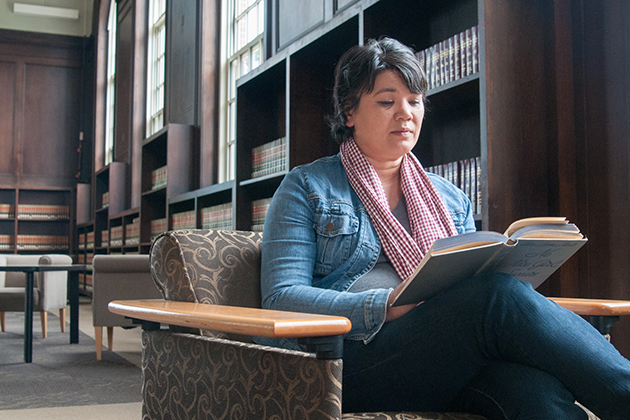For the 2015-2016 academic year, the UConn Reads Steering Committee has selected the theme “Race in America.” The theme is both provocative and poignant, especially in juxtaposition to various current events (such as Ferguson, Baltimore, and #blacklivesmatter) and several significant anniversaries, including the 50th anniversaries of the March on Selma and the subsequent passage of the Voting Rights Act of 1965. The year 2015 is also the 50th anniversary of the 1965 Immigration and Nationality Act, which removed – for the first time in U.S. history — race-based, nation-based quotas from immigration law.

Though I have spent almost half my lifetime in New England (Massachusetts and Connecticut, to be more precise), my true home is roughly 2,000 miles away, in Austin, Texas. I spent my childhood, adolescence, and young adulthood in the Lone Star State.
A lot has changed in the span of two decades. Texas, like the rest of the United States, is increasingly characterized by a diverse population: per the 2010 census, almost 38 percent of the population identifies as Hispanic or Latino, while roughly 12 percent is African American; it is presently home to the fourth largest Vietnamese American population. Since 2000, my hometown has witnessed a 60 percent increase in its Asian American population, marking a dramatic change from the Austin of my youth: indeed, I could count the number of Asian Americans in my school on one hand, and that included me and my twin brother. However, as more and more immigrants come to the United States from all points east, west, north, and south, it is not surprising that by 2042, people of color are projected to be the new American majority.
I left Texas in summer 1998 to attend the University of Massachusetts, Amherst. At the time, I had intended to pursue a graduate degree in English, specializing in Victorian literature. Yet it was an incident in my home state that would – at the time unbeknownst to me – shift the focus of my degree and career.
In trying to understand the contemporary moment, I find that I turn to literature, which is uniquely suited to reflect upon the complex terrain of race in America. — Cathy Schlund-Vials
On June 7, 1998, James Byrd Jr. (African American, aged 49) was brutally beaten and murdered by three white men: Shawn Berry, Lawrence Russell Brewer, and John King. Pretending to offer him a ride home, Berry, Brewer, and King chained Byrd to the back of a pickup truck, and dragged him for 1.5 miles. Byrd’s death would precipitate both the passage of a Texas hate crimes law and the federal Matthew Shepard and James Byrd Jr. Hate Crimes Prevention Act, which was passed on Oct. 22, 2009 and signed into law by President Barack Obama on Oct. 28, 2009.
The recent events in McKinney, Texas have prompted me to revisit both this time and this case. I have watched and re-watched the McKinney video, which shows Officer Eric Casebolt pulling a gun on teenagers in swimsuits and shoving Dajerria Becton, a 15-year-old African American, to the ground at a pool party. Because of the proximity of age and geography – Casebolt and I are both 41 years old and come from the same state – I have considered the possibility that we could have been classmates; I have likewise considered the likelihood that he may have remembered Byrd’s murder.
Yet his actions speak to a very different world view with regard to race, one that both defies declarations of progress, and reflects an all-too-familiar national contradiction. Such race-based confusion brings me to a piece James Baldwin wrote almost 50 years ago, titled “The American Dream and the American Negro.” In response to police brutality in Selma, Ala., Baldwin evocatively points out, “This is not being done 100 years ago, but in 1965 and in a country which is pleased with what we call prosperity, with a certain amount of social coherence, which calls itself a civilized nation and which espouses the notion of freedom in the world.”
In trying to understand the contemporary moment, I find that I turn to literature, which is uniquely suited to reflect upon the complex terrain of race in America. I am drawn to the likes of James Baldwin (particularly The Fire Next Time), Ralph Ellison’s Invisible Man, Richard Wright’s Native Son, and Dina Temple-Raston’s A Death in Texas: A Story of Race, Murder, and a Small Town’s Struggle for Redemption (which focuses specifically on Byrd’s murder and its aftermath) – all of which lay bare a long history of race and an even longer national story of racism. And in attempting to understand the changing face of race in America, Maxine Hong Kingston’s The Woman Warrior, Lan Cao’s Monkey Bridge (about Vietnamese refugees), Richard Rodriguez’s The Hunger of Memory, and Junot Diaz’s The Brief Wondrous Life of Oscar Wao provide a means of exploring through different voices and perspectives the multifaceted and often contested contours of the immigrant experience.
The UConn Reads program was created to bring together the University community – from students, faculty, and staff to alumni and friends of UConn, as well as citizens of Connecticut – for a far-reaching and engaging dialogue centered on a book suggested by the community.
The committee welcomes your nominations for the 2015-16 UConn Reads selection, which can be submitted online. The deadline for nominations is Aug. 1.



